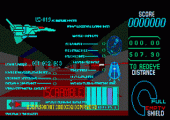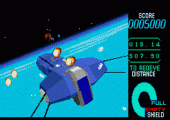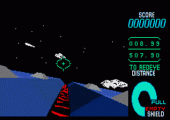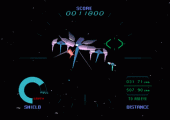Genre: Shmup Developer: Technosoft Publisher: Namco Players: 1 Released: 1994
Advertised as a “hyper-entertainment machine” in Europe and featured as one of the main attractions of Namco Cyberstation on San Francisco’s Pier 39 (Namco’s flagship store in the United States in the ’90s), Starblade was the pinnacle of Japanese arcade technology when it was released in 1991. Powered by the multi-board “Polygonizer” (Namco System 21), it delivered fast-paced, space shooting action with hundreds of real-time, rendered flat-shaded polygons per frame at a solid 60 frames-per-second. As a deluxe sit-down arcade cabinet, it fit a 25-inch monitor directed to a large concave mirror to enhance the visual immersion and four speakers mounted around the player with adjustable front/rear volume balance to take advantage of its 24 PCM channels dedicated to sound effects. It also had a seat which vibrated and strobe lights which flashed every time your ship was hit by enemies.
Starblade was Namco’s ultimate audiovisual experience and represented a major technological evolution when compared to the previous decade’s LaserDisc-based space combat arcade games such as Sega’s Astron Belt and Atari’s Firefox. In 1994, the first conversions were released for both the Sega CD and the 3DO and in 1995 for the PlayStation as Starblade Alpha. Technosoft handled the Sega CD version, while HighTech Lab. Japan was responsible for the 32-bit ones. On the surface, it may look like the 32-bit versions are better, but they are actually inferior and not as true to the source material as the Sega CD’s. And I will cover such differences in this review.
The Sega CD port features the same storyline and base gameplay of the original arcade game, a space combat journey that could be divided into four missions. In the first and shortest one, piloting your ship “Geosword” and firing its laser cannons, you’ll help to defend Mother Planet while leaving it towards Empire’s mechanized planet “Red Eye.” In the second one, you’ll have to navigate through an asteroid field and enemy cruisers while battling with laser star fighters, pentagon fire orbs, and several other enemy spaceships. The third mission will happen inside Red Eye, where you’ll fight enemies flying between canyons and then penetrate the crowded outer defense of power reactor “Octopus.” To destroy Octopus faster, you’ll have to aim solely at the center of the power stone until the very end. Having destroyed Octopus and exploded planet Red Eye, the fourth, final and hardest mission will be to return to your Mother Ship. During this mission you’ll have to neutralize a giant battleship called “Iceberg” by flying into its control center, destroying each one of its six projections (which will fire back at you) and then obliterating its own power stone. This second power stone is harder to destroy and it will send very damaging shockwaves towards your ship until you destroy it. After all this, you’ll still have to face the flagship commander in the final battle.
In the sound department, the Sega CD port is outstanding and far superior to the 32-bit adaptations. Technosoft made great use of the Ricoh sound chip. The sound effects are presented with multiple levels of stereo panning depending on the location of the sound source on screen providing the immersion that the PS1 and 3DO versions lack. The volume of the sound effects is also a bit different depending on how distant they are to the Geosword, as in other version of the game, but out of the console conversions the Sega CD is clearly the one with better sample quality – certainly the clearer sounding one and also with wider range: the explosions are bassy but none of the effects sound muffled. There are also no syncing issues, as in some parts of the 32-bit conversions (especially when entering the Octopus’ power stone room). The only downside in the Sega CD version are the music tracks being presented in mono (since they’re recorded as PCM samples) and the ending/credits track having some clipping noise (which is far more pronounced in emulators and when using devices such as the MegaSD).
Graphically, the Sega CD certainly shows its hardware limitations and lacks some of the “oomph” of the arcade, running slower than the other versions, in a smaller window, and making use of wireframe objects in several instances. However, it’s still a competent recreation of Starblade’s 3D world and it doesn’t resort to FMV backgrounds (see here more details), avoiding the video compression artifacts and stars blurring found in the 32-bit conversions while also providing proper deep black outer space visuals. Another visual characteristic that is better preserved in the Sega CD port is the flashing of the screen when hit by enemies, which is far more pronounced than in the other conversions and in line with the arcade usage of it (concerns with epilepsia are mentioned in the user manual of the home versions, which may explain why it has been toned down in the 32-bit renditions).
In Starblade, the CPU pilots Geosword for you all the time, so you only need to aim and shoot. While very simplistic in concept, the in-game action has lots of intricacies. There are 30 different enemy types, each one with their own kind of weapon, attack pattern, activation time and fire power. The enemies will largely outnumber you in most encounters, so you’ll need to plan ahead your attacks in order to succeed. The incorrect prioritization of your attacks will result in taking several hits in a short period of time, quickly depleting Geosword’s shield. Sometimes you’ll have to choose which hits you’ll risk to take, and in such instances it will be very useful to have a grasp on the different enemy types. Some enemies take more time to shoot but have greater firepower while others may be weak but will fire a lot of projectiles in quick sequence (which will also occlude your vision), some enemies can absorb more hits than others and so on. It’s your job to figure out how to balance all this.
Starblade’s original arcade controls rely on its gun assembly for analog aiming. It has four digital triggers, and all four have the exact same function: firing your laser guns. They also don’t increase the fire rate if triggered together or combined. So it’s very tiring, frustrating, and actually impossible to 1CC the game with this default setup, no matter how fast you push the triggers; It’s not enough. Due to that, in Japan, Namco offered a service to mod the original arcade machine and provide super rapid-fire. It’s not really a regular turbo fire since it’s so fast that it looks more like a continuous laser stream. And that’s the configuration which most of the surviving Starblade machines in Japan use nowadays because that’s the configuration which allowed the game to have a certain cult following there among hardcore players, those who like to play for the scoring records. Such modification option was never available overseas.
In terms of analog aiming, the Sega CD port is, again, your best option since it supports both the Sega Mouse and the Micomsoft XE-1AP controller. The PS1 version offers analog support only for the mouse and the 3DO version is digital-only. On the other hand, to this day, the Sega CD port doesn’t have a known cheat code for rapid or super rapid-fire (while both PS1 and 3DO adaptations have), so you’ll have to rely on controllers with turbo capabilities in order to have enough firepower to be able to perform most of the high-scoring tricks and even be able to try to 1CC the game. With that in mind, the best controller for Sega CD’s Starblade is the XE-1AP since it offers both analog and turbo firing. The second best option (and a far more affordable one) is the QuickShot Chimera 3, which uses a digital stick but allows you to change directions and reach the diagonals quite faster than a regular pad while also providing turbo fire and an ergonomic button layout. Other than that, you can also achieve good results using a turbo controller with a high quality directional pad (has to have diagonals) such as the AsciiPad MD-6 or even the official Sega six-button pads combined with a turbo fire device such as the Tyco Power Plug. The other options I tried had much worse results and really detracted from the experience, such as arcade sticks or the bog-standard Sega three-button controllers.
An interesting and widely unknown quirk of the arcade Starblade is that at certain points of each mission the game can randomly choose one of two possible branches of the path you’re traversing. Such branches differ in flight trajectory and battle angles, while also presenting slightly different enemy waves and patterns. According to veteran Japanese Starblade player “♪HTS”, there are 48 possible path combinations in total, and only one of them allows you to get the highest score possible (around 2,500,000 points) for an 1CC run.
Unlike the 32-bit adaptations, Sega CD’s Starblade (except for the European release) offers two difficult settings: Normal and Hard, and that’s a major highlight of this version since not only those settings change the number of credits, ranking of the enemies and the shield damage rate, but they also represent different rail shooting routes. In the Normal setting, you’ll traverse all the easier path branches, which corresponds to the standard route of the world/international version of the arcade game, the same and only route presented in the 32-bit conversions.
In the Hard setting, you’ll fly across all the harder path branches, which corresponds to the standard route of the original Japanese arcade release. This route is not available in the 32-bit conversions. As the European Mega CD version is locked in the Hard setting, the only route available to the player is the Japanese one despite its attract mode showing the world version route. The credits were also reduced from two to one. In summary, it was a harsh and atrocious localization effort.
The Sega CD port introduces checkpoints instead of pausing and resuming the game upon credit usage. This is a controversial change since it breaks its scoring system once you use a credit (the player score is preserved and accumulates with no penalty after using a credit, which means that by using credits you can artificially inflate your score), but it certainly makes it harder to beat the game by just milking the credits. Pick your poison.
Another gameplay aspect which has been overlooked for many years is that the Sega CD port is the only home conversion which preserves the unscripted and unlimited characteristic of the arcade’s boss fights. Both in the 3DO and PS1 adaptations, also due to their reliance on FMV backgrounds, the boss fights timeout at the exact same point every single time, no matter how good or how poor is your performance in such fights. This is a major departure from the original gameplay, especially when considered alongside the fact that those versions also lack all the harder routes of the game and they also don’t allow you to perform many of the arcade high-scoring tricks that you can still use in the Sega CD version (the enemies can only be hit later than in the arcade/Sega CD in several occasions, shooting through walls is mostly impossible, etc.). This is why I tend to consider the Sega CD version a port of the original Starblade while the 32-bit versions are adaptations in my view.
So, in the end, how good is Sega CD’s Starblade? It’s very good, highly addictive and certainly true to the source material despite all the shortcomings caused by the hardware limitations. I’ve certainly had a blast and a lot of fun playing it in a dark room, using a hi-fi stereo and a proper CRT TV to let the intense screen flashes transport me to another dimension. If you’re a rail shooter fan, this is a game you must play.
Many thanks to ♪HTS (@htsonp on Twitter) and Arcade Life Style/Dragon’s Lair Fans owner for the additional information.
SCORE: 8 out of 10










Starblade actual gameplay is identical to the arcade. Of note is properly timed pulse firing was faster than just holding down the button. All other comments regarding the graphics are valid.